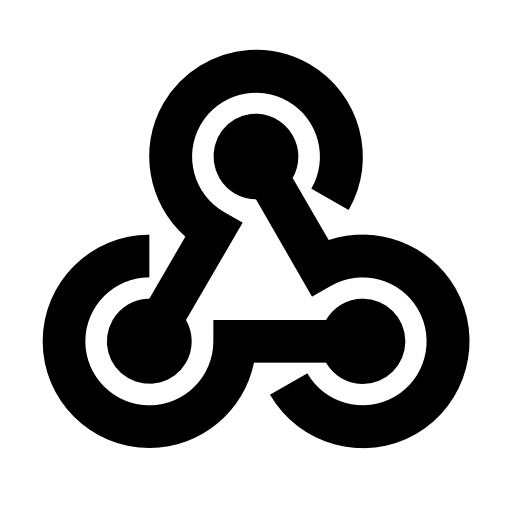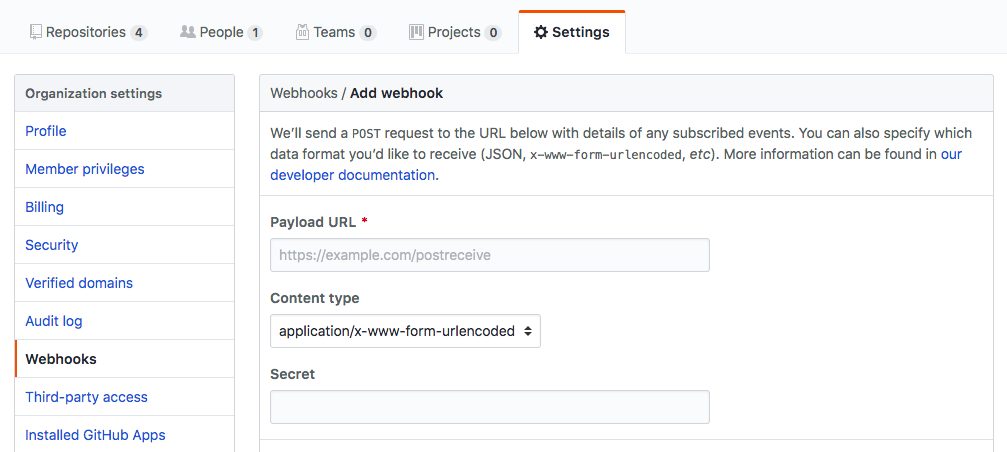The program accepts all incoming GitHub Webhooks events. It evaluates the incoming event and triggers the configured 'action' modules (multiple actions can be associated per Webhook event).
The application can match events to 'actions' based on their type and specific payload content (E.g: github user that is associated with the event)
Events that are not 'registered' in the Yaml config file (no matches found), are being ignored. (see the 'configuration' section for details)
Note: The sample setup in this repository listens for 'Delete Repository' events and creates an 'Issue' in another repository, called 'issue-headRepo'.
This application was developed using Python 2.7.10
Required to access the GitHub API.
curl https://api.github.com/authorizations \
--user "<user>" \
--data '{"scopes":["headRepo","admin:org","gist","notifications","user"],"note":"MyToken"}'The JSON response contains a section called,
"token": "0f8...d84"Make sure to store that token! It cannot be retrieved again. (you can always regenerate a token)
For creating tokens see, GitHub - Creating a personal access token...
Make sure to store the token!
For security reasons, we only accept incoming requests from our GitHub organization !
> uuidgen
C8A1A357-5252-452D-B46D-BF9E325A99D6You can provide any 'string' but we recommend using something similar to the 'uuidgen'.
In your GitHub Organization create a Webhook for an event (for testing purposes select all events).
In the Webhook setup (organization/settings/hooks) provide the secret string from the previous step. Make sure the Webhook points to the correct location (url) for the Webhook listener (and that it's reachable)
See snap shot of Webhooks setup section and secrets
To install the server, clone this repository and copy all files and subfolders from src/ to any location where you want to install the application.
.
├── docs
├── README.md
└── src
├── config.yml
├── modules
│ ├── create_issue.py
│ ├── notification.py
│ └── template.py
└── WebhookEventServer.pyNOTE: the 'modules' folder contains the code for Webhook event actions. To see a sample of how to create a Webhook event action, check 'template.py'.
All configuration is done via the 'config.yml' file, found in the 'src/' folder. The application behavior is fully defined by the config.yml file.
The config.yml consists of two main parts,
- 'server' section, defining all data to run the server
- 'webhooks' section, defining all GitHub events and Webhooks for the application to respond
server:
port: 80 # the port that the application listen for Webhooks
bind: 0.0.0.0 # Application bind IP
log: 'WebhookEventServer.log' # log file/location
secret: top_secret # 'random' string (for incoming Webhook requests)
# GitHub API request info
token_file: 'token.pat' # security token storage (replaces 'token')
token: f7bb2272b...230c1ed9889 # security token (for Github API calls)
github_api: 'https://api.github.com' # GitHub Api endpoint (might be different for on premise)
owner: jdoe
organization: jchallenge1
# list the Webhook events that we want to respond to
webhooks:
# events list from - https://developer.github.com/webhooks/
- event: issues
description: 'GitHub Issue created...'
# the payload_attr acts as a filter option
payload_attrs:
- action: opened
actions:
- notification
- event: repository
description: 'create an issue when a repository gets deleted'
payload_attrs:
- action: deleted
actions:
- create_issue
- event: issues
description: 'GitHub Issue closed...'
payload_attrs:
- action: closed
actions:
| Parameter | Description |
|---|---|
| - event: | any event listed in https://developer.github.com/webhooks/ |
| payload_attrs: | Any top level Yaml tag, with it's value can be provided here. |
| - action: opened | The Application will use it as a 'filter' to identify a Webhook event more specifically. For possible attributes check the 'Events API payload' section from https://developer.github.com/webhooks/ |
| actions: | any number of actions can be provided here as long as it exist in the 'modules' folder |
| - create_issue | python file in the 'modules' folder |
| - notification | python file in the 'modules' folder |
# python WebhookEventServer.py -h
usage: WebhookEventServer.py [-h] [--loglevel LOG_LEVEL]
optional arguments:
-h, --help show this help message and exit
--loglevel LOG_LEVEL, -l LOG_LEVEL
LOG_LEVEL: <debug|info|warning|error|critical>
(default: INFO)Sample:
# python WebhookEventServer.py
Start listening on 0.0.0.0:80The server is now listening on port 80 for incoming GitHub Webhook events !
NOTE: Ports below 1024 are 'Privileged Ports' and require 'root' privileges
curl -d "@./data.json" -u jefeish:cc5...cf75 -X POST https
://api.github.com/repos/jchallenge1/issue-headRepo/issues- -d payload
- -u user:token
{
"title": "Found a bug",
"body": "@user I'm having a problem with this.",
"assignees": [
"myuser"
],
"labels": [
"bug"
]
}import requests
global log
# Required class name
class command():
# initialize the class
def __init__(self, logger, server_info, payload):
global log
# webhook action requires this
self.server_info = server_info
self.payload = payload
log = logger
# Common entry point
def execute(self):
global log
# Implement action


